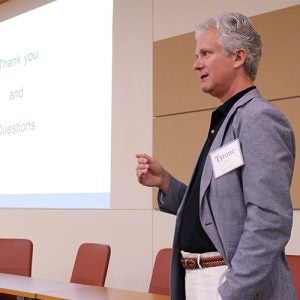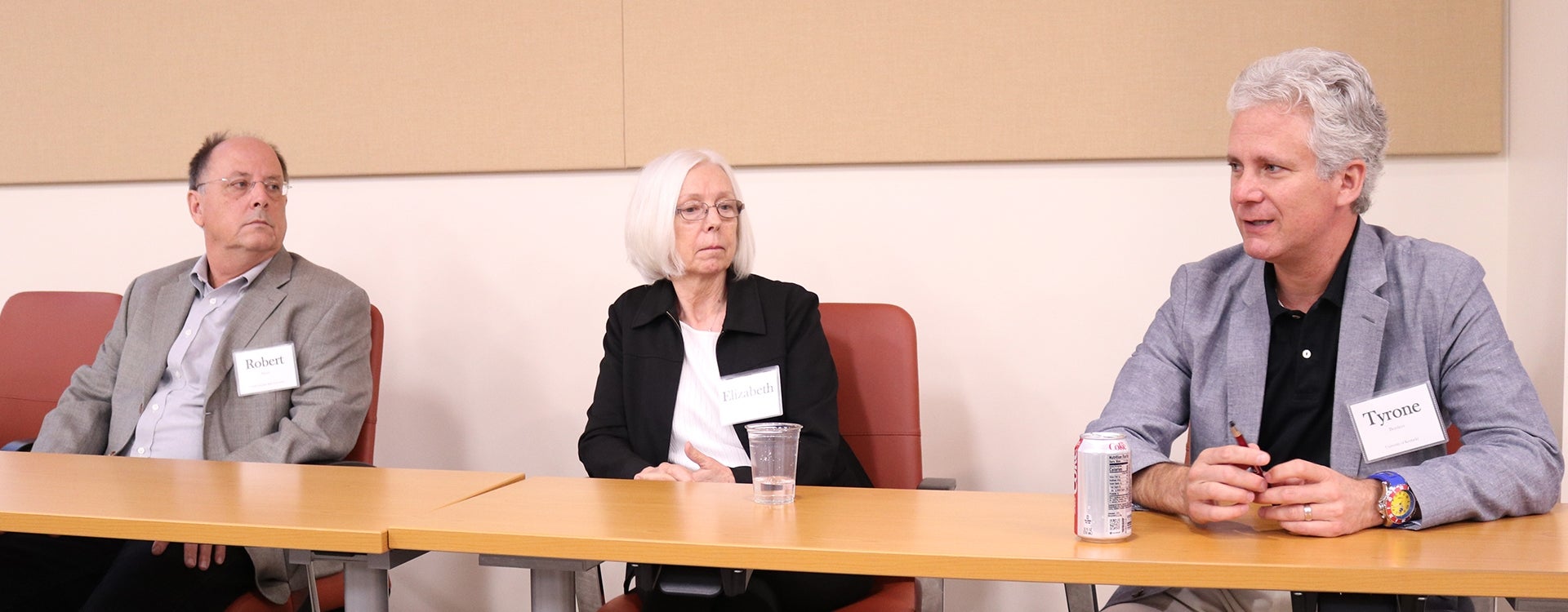REDE Retreat Discusses Interdisciplinary Research
Cross-discipline research was the topic at hand June 20 at the 2018 Research, Economic Development and Engagement Interdisciplinary Research Retreat held at Greenville’s Eastern Area Health Education Center.
More than 80 East Carolina University researchers and department leaders joined REDE for the event, which included guest speakers from the University of Kentucky, North Carolina State University and the National Science Foundation.
The retreat focused on the growing role and success of interdisciplinary research at major universities.
Interdisciplinary research is a type of research done by teams that integrates information, data, tools, perspectives and techniques across academic departments. This type of work brings together engineers, biologists, economists and psychologists, for example, to solve a need.
“We want our researchers to cross traditional academic boundaries and work together to support ECU’s research mission,” said Jay Golden, vice chancellor for research, economic development and engagement. “It’s a difficult process to begin; it’s not easy reaching across departments to find one another and create meaningful partnerships. However, we have to start reaching across disciplines to come up with solutions to the health, educational and economic disparities our region faces.”
Current trends
Elizabeth Blood, program director at the NSF, said her organization has seen a shift in funding from individual-led projects to team-oriented interdisciplinary research projects.
From 2004-13, NSF funding for multiple primary investigator research projects rose 40 percent from $1.5 billion to $2.1 billion. The rise has been stark in science and engineering funding, Blood said, with more team-led papers receiving acknowledgments from academic publications.

Tyrone Borders, director of the University of Kentucky’s Rural and Underserved Health Research Center, discusses rural health trends at the 2018 REDE Interdisciplinary Research Retreat.
“We’re seeing a convergence in research toward working together to solve specific and compelling problems with deep integration across disciplines,” Blood said. “Interdisciplinary research combines knowledge, methods and expertise from different disciplines, allowing research to form new frameworks that advance scientific discovery and innovation.”
Blood said the NSF has shifted its focus to 10 big ideas – including harnessing data, understanding the “rules” of life and navigating the new Arctic. The foundation provides tools to help researchers solve these problems, including its solicited interdisciplinary programs, research centers, education training and the National Ecological Observatory Network.
The NSF also provides best practices for team-led interdisciplinary research, including project management guidelines, technology application and training strategies.
“Researchers and universities have to take into account that interdisciplinary teams are not only built upon intellectual skill,” Blood said. “You have to take into account that project leadership, project management, data management and innovative training techniques are necessary pieces of grant proposals.”
Interdisciplinary success and rural health
N.C. State University’s Robert Smart also touched on the benefits of interdisciplinary research, specifically within his university’s research clusters and its Center for Human Health and the Environment.
In 2011, N.C. State launched its Chancellor’s Faculty Excellence Program, which brought together researchers across a range of academic disciplines to tackle global issues. While the creation of the clusters took time to develop, Smart said that the university has seen early successes from its 20 cluster programs. The programs include topics ranging from digital transformation of education to genetic engineering and society.
“The creation of our clusters allowed faculty to create new interdisciplinary groups and have new interactions between and within disciplines,” Smart said. “It was a bottom-up process with faculty proposals and submissions driving the problems our clusters aim to solve.”
Smart also described the development of N.C. State’s Center for Human Health and the Environment, which promotes interdisciplinary research not only at N.C. State, but also at other academic institutions. Six ECU researchers are members of the CHHE.
“CHHE has developed three interdisciplinary research teams that cut across different disciplines including genomics, veterinary and human medicine, epidemiology, exposure science, statistics, bioinformatics, genetics, cell and developmental biology, and toxicology,” Smart said. “We’re using researchers from different academic areas to solve problems like GenX contamination in the Cape Fear River and providing data for student and teacher professional development programs and activities.”
Tyrone Borders, director of the University of Kentucky’s Rural and Underserved Health Research Center, added that interdisciplinary research can be done on a variety of topics pertinent to eastern North Carolinians.
“In the future, population health – including understanding widening mortality rates and increasing suicide rates – and facilitating rural health care access are going to be important research topics,” Borders said. “These topics pull in researchers from economics, psychology, sociology, public policy and epidemiology, creating an environment that not only fosters research across disciplines, but one that has to have interdisciplinary research to survive.”
ECU’s research mission
In conjunction with ECU’s Rural Prosperity Initiative, the university has increased interdisciplinary research efforts.
In 2017, ECU launched seven university-wide research clusters – with an eighth planned this fall – that provide a framework for fostering interdisciplinary research, outreach and engagement. The clusters bridge the gap between industries and ECU’s research projects, which makes it easy for researchers to pursue innovative research that forges new intellectual directions and discoveries.
ECU and REDE are also exploring ways to highlight researchers for their interdisciplinary efforts. The division has changed how sponsored awards are credited. Faculty on interdisciplinary projects can have a portion of the award credited to them and to their departments and colleges so that the value of the individual contribution to the team is acknowledged and accounted for.
In addition, REDE funds, which in previous years were used to support pilot projects and preliminary data gathering, will be funneled through ECU’s research clusters, which are interdisciplinary in nature.
“It’s important that our faculty, staff and students support the growth of research on campus,” Golden said. “REDE is a service organization. We want to support our faculty and students in their pursuit of research activities to make positive impacts in our region.
“We’re going to continue to work to find ways to overcome barriers to interdisciplinary research so we can become America’s next great national university,” he said.
